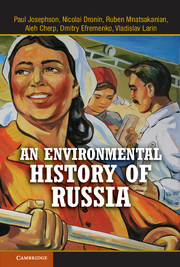Book contents
- Frontmatter
- Contents
- Introduction
- 1 From Imperial to Socialist Nature Preservation
- 2 Stalinism
- 3 The Khrushchev Reforms, Environmental Politics, and the Awakening of Environmentalism, 1953–1964
- 4 Developed Socialism, Environmental Degradation, and the Time of Economic “Stagnation,” 1964–1985
- 5 Gorbachev's Reforms, Glasnost, and Econationalism
- Conclusion After the Breakup of the Soviet Union
- Index
- References
3 - The Khrushchev Reforms, Environmental Politics, and the Awakening of Environmentalism, 1953–1964
Published online by Cambridge University Press: 05 April 2013
- Frontmatter
- Contents
- Introduction
- 1 From Imperial to Socialist Nature Preservation
- 2 Stalinism
- 3 The Khrushchev Reforms, Environmental Politics, and the Awakening of Environmentalism, 1953–1964
- 4 Developed Socialism, Environmental Degradation, and the Time of Economic “Stagnation,” 1964–1985
- 5 Gorbachev's Reforms, Glasnost, and Econationalism
- Conclusion After the Breakup of the Soviet Union
- Index
- References
Summary
At the end of World War II, the Communist Party approved the fourth Five-Year Plan (1946–1951), which, like the first Five-Year Plans, was dedicated to building – and in this case also rebuilding – the country's heavy industry and military sectors. As in the 1930s, investment income was extracted from the agricultural sector, whereas housing, light industry, and medicine were ignored. A famine in 1946 killed hundreds of thousands of people. Millions of citizens lived in burned-out hovels, rubble, or holes in the ground. The Stalinist Plan for the Transformation of Nature (1948) ensured that nature, too, no less than Soviet citizens, would serve reconstruction purposes through the taming of its resources and through its coal, oil and rivers generating power. The Soviet Union was an industrial economy, yet leaders had superimposed it on a backward agricultural community, and the economy remained dependent on forced labor in such sectors as mining, timber, fossil fuels, and power production. This was the Stalinist centrally planned economy, with its ability to mobilize resources fully and harshly, if not rationally.
When Stalin died in March 1953, a succession struggle broke out between Georgy Malenkov, Viacheslav Molotov, secret police chief Lavrenty Beria, and Nikita Khrushchev. By 1956, Khrushchev had won this struggle and embarked fully on a reform program that included the economy, culture, and society. After the novel The Thaw (Ottopel’, originally published in the journal Novyi Mir) by Ilya Ehrenburg, the Khrushchev era became known as the “thaw” period. De-Stalinization became the official policy, especially after Khrushchev condemned the excesses of Stalinism in a special session at the close of the twentieth Communist Party Congress in February 1956.
- Type
- Chapter
- Information
- An Environmental History of Russia , pp. 136 - 183Publisher: Cambridge University PressPrint publication year: 2013



